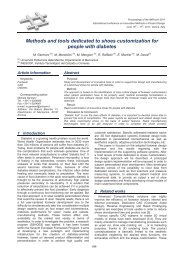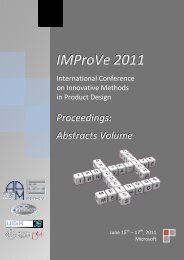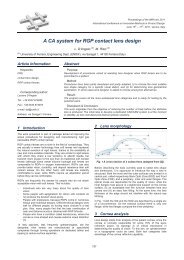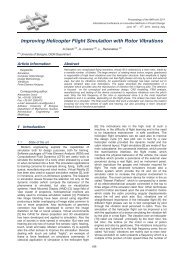IMProVe 2011 - Proceedings
IMProVe 2011 - Proceedings
IMProVe 2011 - Proceedings
Create successful ePaper yourself
Turn your PDF publications into a flip-book with our unique Google optimized e-Paper software.
Surveying, Mapping and GIS Techniques<br />
Robust surface matching<br />
as a rapid technique for terrain change detection<br />
F. J. Aguilar (a), I. Fernández (a), M. A. Aguilar (a), J. Delgado (b), J. G. Negreiros (c), J. L. Pérez (b)<br />
(a) Department of Agricultural Engineering, University of Almería, La Cañada de San Urbano, Spain<br />
(b) Department of Cartographic Engineering, Geodesy and Photogrammetry, University of Jaén, Spain<br />
(c) ISEGI, Universidade Nova de Lisboa, Lisboa, Portugal<br />
Abstract:<br />
Digital elevation models (DEMs) are widely used in GIS to predict the impact of coastal<br />
flooding and Sea Level Rise in coastal areas. Furthermore, DEM change detection within a<br />
certain time period may be also used to automatically quantify the coastal landscape<br />
changes. In this sense many researchers have adopted 3D surface matching techniques<br />
without control points (GCPs) to automatically co-register multi-temporal DEMs.<br />
In this paper a new approach based on robust surface matching for DEM 3D georeferencing<br />
is proposed to avoid the costly and time-consuming necessity of GCPs. The<br />
algorithm starts from a coarse orientation of the historical DEM where the stereo model y-<br />
parallax is removed by means of an Automatic Relative Orientation. Additionally, it is<br />
necessary to manually mark three control points to apply a coarse Helmert 3D<br />
transformation, obtaining a preoriented stereo-pair which turned out to be helpful to<br />
improve and speed up the subsequent surface matching process. Absolute z-differences<br />
between reference and historical DEMs are calculated, allowing for the application of the<br />
widely known K-means algorithm to cluster up to four groups of homogeneous absolute<br />
differences. The two clusters showing the high values are considered as outliers or areas<br />
where terrain has significantly changed. The remaining areas are deemed as potentially<br />
matching areas where the robust surface matching can be applied using the M-estimator<br />
called Tukey’s Biweight (TB). In this way the diagonal weight matrix, regarding TB function,<br />
is introduced in an iterative least square routine to compute the Helmert 3D<br />
transformation parameters.<br />
The proposed methodology was tested for geo-referencing a historical grid format DEM,<br />
comprising a little coastal area of Almeria (South Spain), obtained by digital stereophotogrammetry<br />
from a B&W photogrammetric flight taken in 1977 at an approximated<br />
scale of 1:18000. The reference DEM was the 10 m grid-spacing digital elevation model<br />
produced by the Andalusia Regional Government (Spain) from a 1:20000 scale B&W<br />
photogrammetric flight taken in 2001. As well, we counted on two accurate DEMs based<br />
on LiDAR technology (ground truth) taken in 2005 and 2009 respectively.<br />
The results obtained from this work may be deemed as very promising, showing a high<br />
efficiency and accuracy for historical DEM 3D geo-referencing. After the application of the<br />
robust surface matching for non-altered or stable areas, the computed uncertainty,<br />
measured as standard deviation of DEM z-differences, turned out to be 1.08 m. That is<br />
quite similar to the estimated uncertainty for the reference model (around 1.03 m).<br />
June 15 th – 17 th , <strong>2011</strong>, Venice, Italy<br />
155<br />
<strong>IMProVe</strong> <strong>2011</strong> - <strong>Proceedings</strong>










